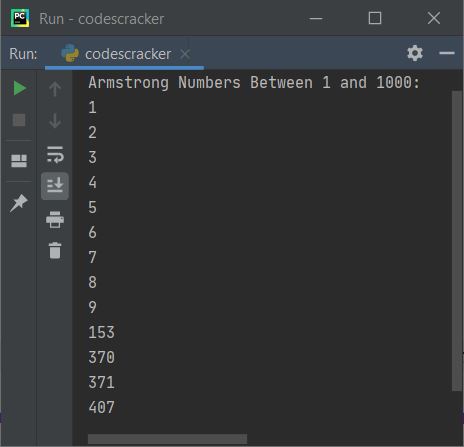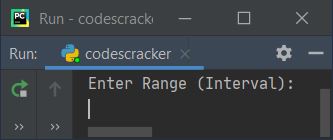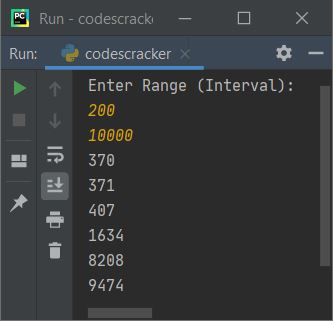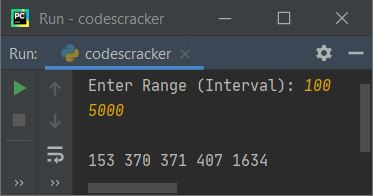- Python Basic Programs
- Python Program Examples
- Python Print Hello World
- Python Get Input from User
- Python Add Two Numbers
- Add Subtract Multiply Divide
- Python Check Even or Odd
- Python Check Prime or Not
- Python Check Alphabet or Not
- Python Check Vowel or Not
- Python Check Leap Year or Not
- Check Reverse equal Original
- Check Positive Negative Zero
- Python Check Armstrong or Not
- Python Check Palindrome or Not
- Python Check Perfect Number
- Python Find Reverse of Number
- Python Count Digits in Number
- Python Add Digits of Number
- Sum of First and Last Digits
- Python Product of Mid Digits
- Sum of Squares of Digits
- Interchange Digits of Number
- Python Sum of n Numbers
- Python Print ASCII Values
- Python Swap Two Numbers
- Python Swap Two Variables
- Python Fahrenheit to Celsius
- Python Celsius to Fahrenheit
- Python Display Calendar
- Python Days into Years, Weeks
- Find Largest of Two Number
- Find Largest of Three Number
- Python Print Fibonacci Series
- Generate Armstrong Numbers
- Python Make Simple Calculator
- Python Add Binary Numbers
- Binary Number Multiplication
- Python Mathematical Programs
- Find Sum of Natural Numbers
- Find Average of n Numbers
- Python Print Multiplication Table
- Print Table using Recursion
- Python Find Average Percentage
- Python Find Grade of Student
- Find Square Root of Number
- Python Print Prime Numbers
- Find Numbers Divisible by
- Python Find Factors of Number
- Python Find Factorial of a Number
- Python Find HCF & LCM
- Python Kilometres to Miles
- Python Find Area of Square
- Python Find Area of Rectangle
- Python Find Area of Triangle
- Python Find Area of Circle
- Python Find Perimeter of Square
- Find Perimeter of Rectangle
- Python Find Perimeter of Triangle
- Find Circumference of Circle
- Python Simple Interest
- Python Solve Quadratic Equation
- Python Different Set of Operations
- Python Display Powers of 2
- Python Find nCr & nPr
- Python Pattern Programs
- Python Print Pattern Programs
- Python Print Diamond Pattern
- Python Print Floyd's Triangle
- Python Print Pascal's Triangle
- Python List Programs
- Python Count Even/Odd in List
- Python Positive/Negative in List
- Python Even Numbers in List
- Python Odd Numbers in List
- Python Sum of Elements in List
- Sum of Odd/Even Numbers
- Python Element at Even Position
- Python Element at Odd Position
- Python Search Element in List
- Python Largest Number in List
- Python Smallest Number in List
- Python Second Largest in List
- Python Second Smallest in List
- Python Insert Element in List
- Python Delete Element from List
- Python Multiply Numbers in List
- Swap Two Elements in List
- Python 1D Array Program
- Python Linear Search
- Python Binary Search
- Python Insertion Sort
- Python Bubble Sort
- Python Selection Sort
- Remove Duplicates from List
- Python Reverse a List
- Python Merge Two List
- Python Copy a List
- Python Conversion Programs
- Python Decimal to Binary
- Python Decimal to Octal
- Python Decimal to Hexadecimal
- Python Binary to Decimal
- Python Binary to Octal
- Python Binary to Hexadecimal
- Python Octal to Decimal
- Python Octal to Binary
- Python Octal to Hexadecimal
- Python Hexadecimal to Decimal
- Python Hexadecimal to Binary
- Python Hexadecimal to Octal
- Python Matrix Programs
- Python Add Two Matrices
- Python Subtract Two Matrices
- Python Transpose Matrix
- Python Multiply Matrices
- Python String Programs
- Python Print String
- Python Find Length of String
- Python Compare Two Strings
- Python Copy String
- Python Concatenate String
- Python Reverse a String
- Python Swap Two Strings
- Python Uppercase to Lowercase
- Python Lowercase to Uppercase
- Python Check Substring in String
- Python Count Character in String
- Count Repeated Characters
- Python Count Word in Sentence
- Python Count Each Vowels
- Python Capitalize Character
- Python Capitalize Word in String
- Python Smallest/Largest Word
- Remove Spaces from String
- Remove Duplicate Character
- Remove Vowels from String
- Remove Punctuation from String
- Python Remove Word in String
- Python Remove Duplicate Words
- WhiteSpace to Hyphens
- Replace Vowels with Character
- Replace Character in String
- Python Sort String in Alphabetical
- Sort Word in Alphabetical Order
- Extract Number from String
- Python Check Anagram Strings
- Python File Programs
- Python Read a File
- Python Write to File
- Python Append Text to File
- Python Copy Files
- Python Merge Two Files
- Python Counts Characters in File
- Python Count Words in File
- Python File Content in Reverse
- Python Lines Contains String
- Python Delete Line from File
- Python Capitalize Word in File
- Python Replace Text in File
- Replace Specific Line in File
- Python Find Size of File
- Python List Files in Directory
- Python Delete Files
- Python Misc Programs
- Python Reverse a Tuple
- Python Merge Two Dictionary
- Python bytes to String
- Python bytearray to String
- Generate Random Numbers
- Python Print Address of Variable
- Python Print Date and Time
- Python Get IP Address
- Python Shutdown/Restart PC
- Python Tutorial
- Python Tutorial
Python Program to Generate Armstrong Numbers
This article is created to cover some programs in Python, that generates Armstrong numbers. Here are the list of programs:
- Generate and Print Armstrong Numbers from 1 to 1000
- Generate and Print Armstrong Numbers in Given Range or Interval
Before creating these programs, let's remind about Armstrong numbers.
What are Armstrong Numbers ?
Any number that equals to sum of its own digits, where each digit raised to the power of number of digits. For example, 1634 is an Armstrong number. because:
14 + 64 + 34 + 44 = 1 + 1296 + 81 + 256 = 1297 + 337 = 1634
Note - Since 1634 is a 4-digit number, therefore each of its digit are raised to the power of 4
Generate and Print Armstrong Numbers from 1 to 1000
To generate Armstrong numbers in python, you have to ask from user to enter the interval (starting and ending number), then generate and print Armstrong numbers between given range like shown in the program given below.
The question is, write a Python program to generate Armstrong numbers from 1 to 1000. Here is its answer:
print("Armstrong Numbers Between 1 and 1000:") first = 1 last = 1000 while first<=last: res = 0 temp = first noOfDigit = 0 while temp>0: temp = int(temp/10) noOfDigit = noOfDigit + 1 num = first while num>0: rem = num%10 pow = 1 i = 0 while i<noOfDigit: pow = pow*rem i = i+1 res = res+pow num = int(num/10) if res == first: print(res) first = first+1
The snapshot given below shows the sample output produced by this Python program:

The dry run of above program goes like:
- Initial values, first = 1, last = 1000
- Now the condition (of while loop) first<=last or 1<=1000 evaluates to be true, therefore program flow goes inside the loop or inside the block of while loop
- And 0 gets initialized to res, then first or 1 gets initialized to temp, and 0 gets initialized to noOfDigit
- Now the condition (of inner while loop) temp>0 or 1>0 evaluates to be true, therefore program flow goes inside this loop's block
- And int(temp/10) or int(1/10) or 0 gets initialized to temp. Then noOfDigit+1 or 0+1 or 1 gets initialized to noOfDigit
- first or 1 gets initialized to num and the condition num>0 or 1>0 evaluates to be true, therefore program flow goes inside this loop's block
- num%10 or 1%10 or 1 gets initialized to rem, 1 gets initialized to pow and 0 gets initialized to i
- The condition i<noOfDigit or 0<1 evaluates to be true, therefore program flow goes inside this loop's block and evaluates all its statement
- That is, pow*rem or 1*1 or 1 gets initialized to pow, i+1 or 0+1 or 1 gets initialized to i
- res+pow or 0+1 or 1 gets initialized to res, and int(num/10) or int(1/10) or 0 gets initialized to num
- Now the condition of if, that is res == first or 0 == 1 evaluates to be false, therefore program flow does not goes inside it's body. This condition is applied, to check and print Armstrong number.
- Then first+1 or 1+1 or 2 gets initialized to first
- Now program flow again evaluates the condition of second inner while loop
- That is, the condition num>0 or 0>0 evaluates to be false, therefore program flow does not goes inside this loop's block. Rather it goes and evaluates the condition of outermost (first) while loop
- That is, the condition first<=last or 2<=1000 evaluates to be true again therefore program flow again goes inside the loop.
- This process continues until the condition evaluates to be false
Generate Armstrong Numbers in Given Range
This program receives interval (range) from user to generate and print Armstrong numbers between given range.
print("Enter Range (Interval): ") first = int(input()) last = int(input()) if first>last: temp = first first = last last = temp while first<=last: res = 0 temp = first noOfDigit = 0 while temp>0: temp = int(temp/10) noOfDigit = noOfDigit + 1 num = first while num>0: rem = num%10 pow = 1 i = 0 while i<noOfDigit: pow = pow*rem i = i+1 res = res+pow num = int(num/10) if res == first: print(res) first = first+1
Here is its sample run:

Now supply the input say 200 and 10000 as range or interval to find and print all Armstrong numbers between this range like shown in the snapshot given below:

Modified Version of Previous Program
This is the modified version of previous program, uses try-except to handle with invalid inputs. The str() converts any type of value to a string type. The len() used in this program to find length of string (indirectly used to calculate number of digits):
print("Enter Range (Interval): ", end="") try: first = int(input()) try: last = int(input()) if first>last: temp = first first = last last = temp print() while first<=last: res = 0 noOfDigit = len(str(first)) num = first while num>0: rem = num%10 res = res + (rem ** noOfDigit) num = int(num/10) if res == first: print(res, end=" ") first = first+1 print() except ValueError: print("\nInvalid Input!") except ValueError: print("\nInvalid Input!")
Here is its sample run with range input as 100 and 5000:

Same Program in Other Languages
« Previous Program Next Program »